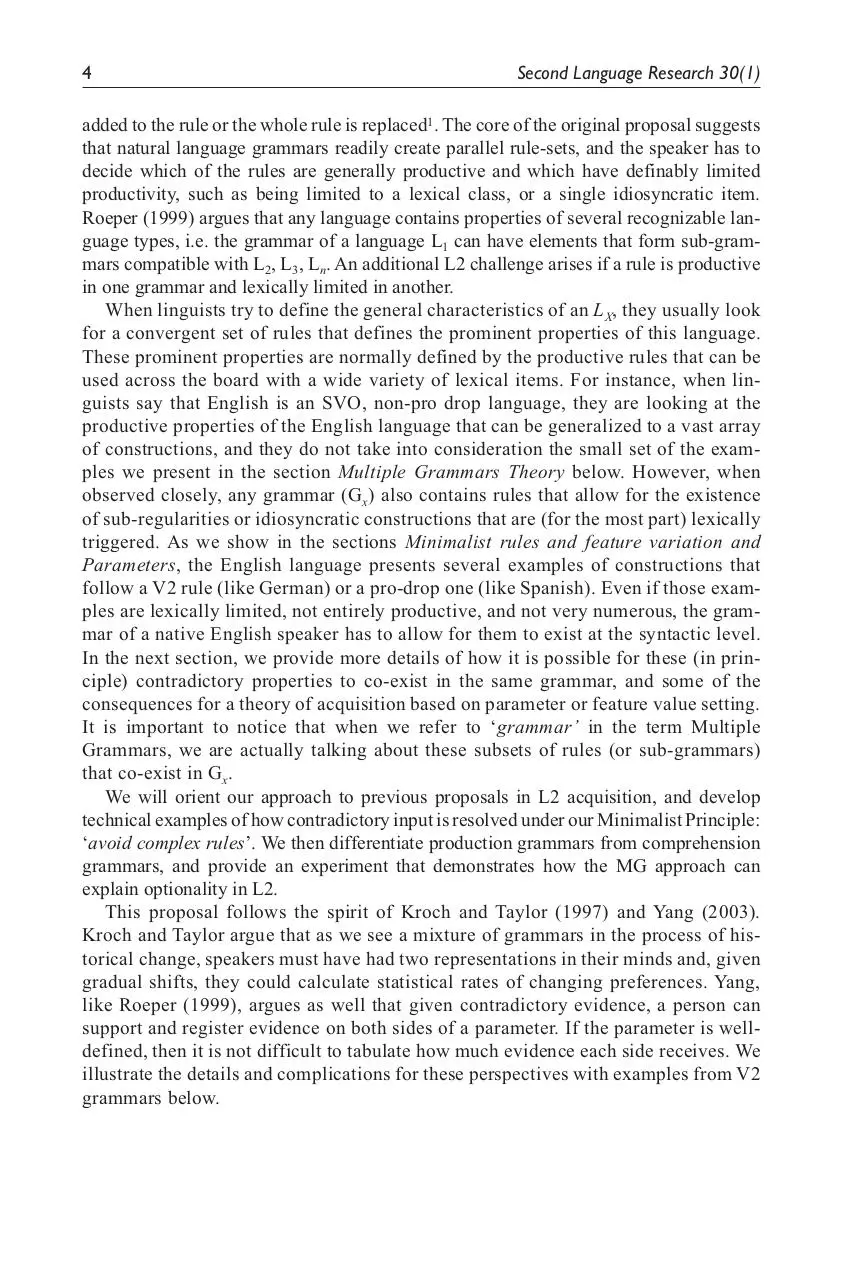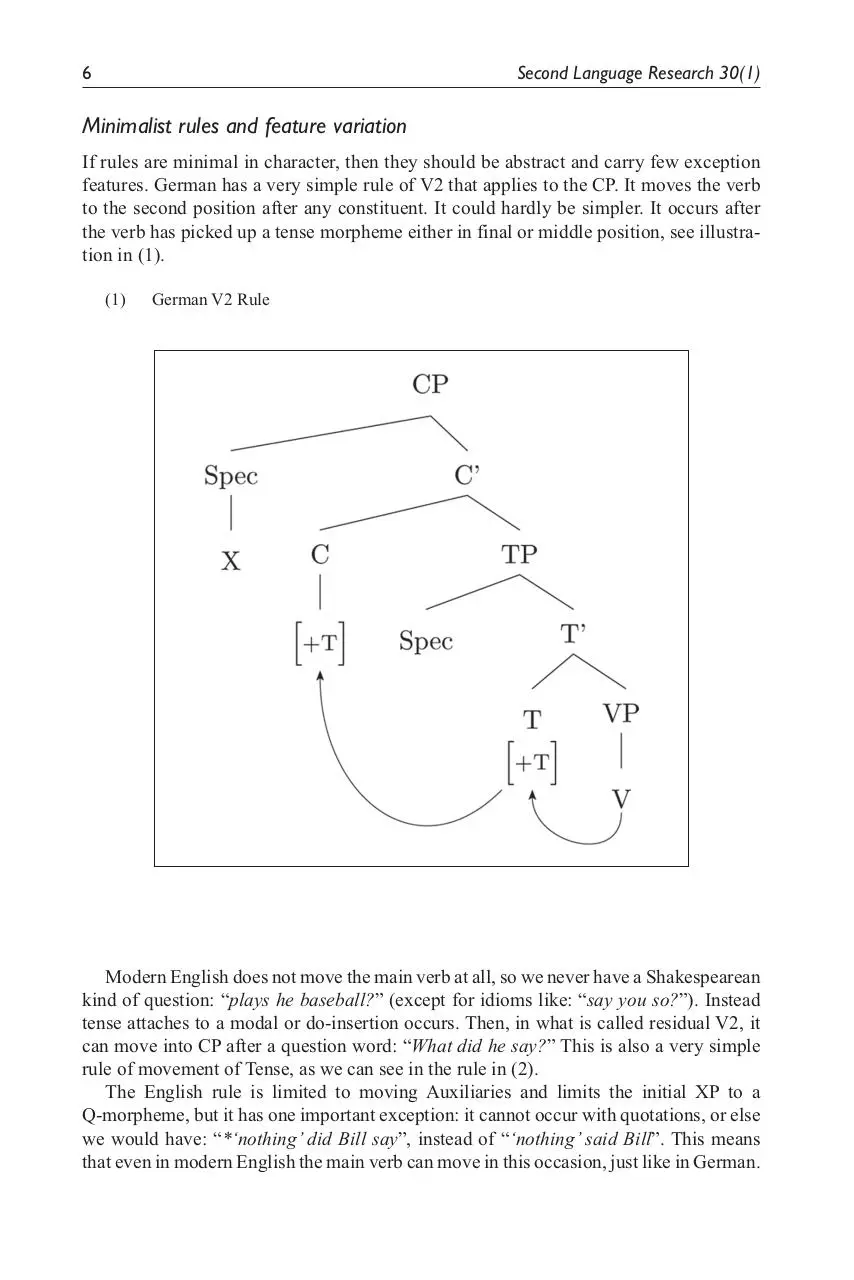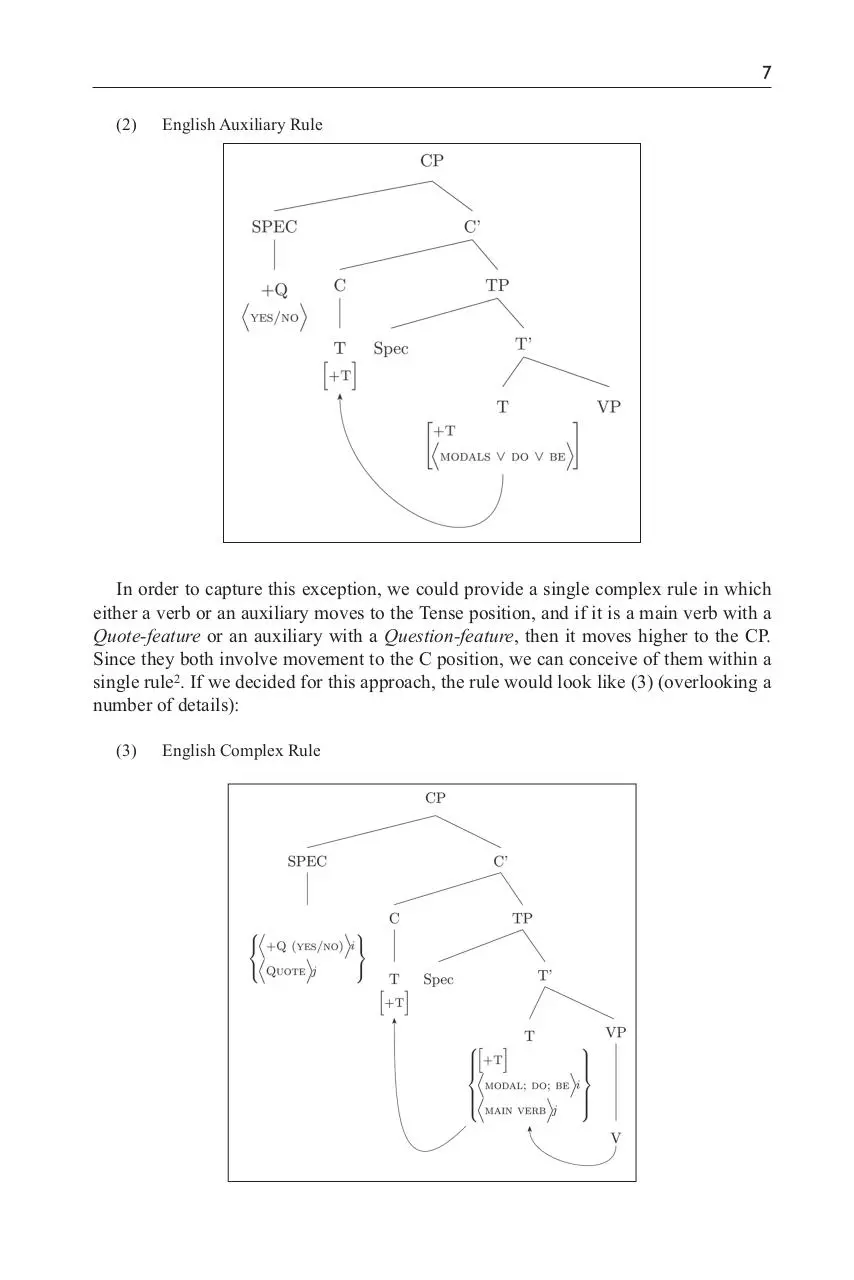7 (PDF)
File information
Title: SLR519017.indd
This PDF 1.3 document has been generated by Adobe InDesign CS5.5 (7.5) / Mac OS X 10.10 Quartz PDFContext, and has been sent on pdf-archive.com on 12/11/2014 at 10:09, from IP address 129.215.x.x.
The current document download page has been viewed 925 times.
File size: 510.41 KB (35 pages).
Privacy: public file





File preview
519017
research-article2013
SLR30110.1177/0267658313519017
Article
Multiple Grammars and Second
Language Representation
second
language
research
Second Language Research
2014, Vol. 30(1) 3–36
© The Author(s) 2013
Reprints and permissions:
sagepub.co.uk/journalsPermissions.nav
DOI: 10.1177/0267658313519017
slr.sagepub.com
Luiz Amaral and Tom Roeper
University of Massachusetts Amherst
Abstract
Move2 This paper presents an extension of the Multiple Grammars Theory (Roeper, 1999) to provide a
step1 formal mechanism that can serve as a generative-based alternative to current descriptive models
of interlanguage. The theory extends historical work by Kroch and Taylor (1997), and has been
Move1 taken into a computational direction by Yang (2003). The proposal is based on the idea that any
step2 human grammar readily accommodates sets of rules in sub-grammars that can seem (apparently)
contradictory. We discuss the rationale behind this proposal and establish a dialogue with recent
Move3 research in SLA, multilingualism, L3 acquisition, and L2 processing. We compare the Multiple
step1 Grammars explanation to optionality in L2 to other current proposals, and provide experimental
results that can demonstrate the existence of active sub-grammars in the linguistic representation
of L2 speakers.
Keywords
Multiple Grammars, Interlanguage, Universal Bilingualism, Second Language Acquisition, UG.
Introduction
Multiple Grammars (MG) is a theory of representation and acquisition that was originally proposed by Roeper (1999) to explain how idiosyncratic, incompatible rules could
co-exist in adult monolingual grammars, and how they played a role in child first language acquisition. The extension of a model that was also called Universal Bilingualism
to describe the interlanguage representation in adult second language learners, and bilinguals in general, seems to be an obvious next step, although the consequences of this
extension are not necessarily trivial.
Different from traditional learnability theory, MG does not presuppose that new input
requires the speaker to change a rule in the grammar in a way that either information is
Corresponding author:
Luiz Amaral, University of Massachusetts Amherst, 300 Massachusetts Avenue, Amherst, MA 01003, United
States.
Email: amaral@spanport.umass.edu
4
Second Language Research 30(1)
added to the rule or the whole rule is replaced1. The core of the original proposal suggests
that natural language grammars readily create parallel rule-sets, and the speaker has to
decide which of the rules are generally productive and which have definably limited
productivity, such as being limited to a lexical class, or a single idiosyncratic item.
Roeper (1999) argues that any language contains properties of several recognizable language types, i.e. the grammar of a language L1 can have elements that form sub-grammars compatible with L2, L3, Ln. An additional L2 challenge arises if a rule is productive
in one grammar and lexically limited in another.
When linguists try to define the general characteristics of an LX, they usually look
for a convergent set of rules that defines the prominent properties of this language.
These prominent properties are normally defined by the productive rules that can be
used across the board with a wide variety of lexical items. For instance, when linguists say that English is an SVO, non-pro drop language, they are looking at the
productive properties of the English language that can be generalized to a vast array
of constructions, and they do not take into consideration the small set of the examples we present in the section Multiple Grammars Theory below. However, when
observed closely, any grammar (Gx) also contains rules that allow for the existence
of sub-regularities or idiosyncratic constructions that are (for the most part) lexically
triggered. As we show in the sections Minimalist rules and feature variation and
Parameters, the English language presents several examples of constructions that
follow a V2 rule (like German) or a pro-drop one (like Spanish). Even if those examples are lexically limited, not entirely productive, and not very numerous, the grammar of a native English speaker has to allow for them to exist at the syntactic level.
In the next section, we provide more details of how it is possible for these (in principle) contradictory properties to co-exist in the same grammar, and some of the
consequences for a theory of acquisition based on parameter or feature value setting.
It is important to notice that when we refer to ‘grammar’ in the term Multiple
Grammars, we are actually talking about these subsets of rules (or sub-grammars)
that co-exist in Gx.
We will orient our approach to previous proposals in L2 acquisition, and develop
technical examples of how contradictory input is resolved under our Minimalist Principle:
‘avoid complex rules’. We then differentiate production grammars from comprehension
grammars, and provide an experiment that demonstrates how the MG approach can
explain optionality in L2.
This proposal follows the spirit of Kroch and Taylor (1997) and Yang (2003).
Kroch and Taylor argue that as we see a mixture of grammars in the process of historical change, speakers must have had two representations in their minds and, given
gradual shifts, they could calculate statistical rates of changing preferences. Yang,
like Roeper (1999), argues as well that given contradictory evidence, a person can
support and register evidence on both sides of a parameter. If the parameter is welldefined, then it is not difficult to tabulate how much evidence each side receives. We
illustrate the details and complications for these perspectives with examples from V2
grammars below.
5
In sum, while Roeper (1999), Kroch and Taylor (1997), and Yang (2003) argue that
the constant presence of incompatible sub-grammars in human language is responsible
for dialectal variation in adult grammars, diachronic language change, and variation in
L1 acquisition; we argue, in this paper, that it is also the primary source for optionality in
all stages of adult L2 acquisition.
Multiple Grammars Theory
The argument that we are all bilingual (universal bilingualism) has intuitive, empirical,
and technical dimensions. Several factors in modern linguistic theory make Multiple
Grammars inevitable: (i) Modularity – a variety of modules with different primitives:
thematic theory, binding theory, movement theory; (ii) Minimalist Rules – a vision of the
statement of rules that requires minimal representations; (iii) Lexicon – a lexicon whose
information is both idiosyncratic and carries partial representations of many modules;
(iv) Interfaces – interface requirements which must obey their own restrictive principles.
All of these factors will lead to the postulation of distinct sub-grammars within a given
language.
It is valuable to bear in mind a non-idealized empirical dimension as well. It is
a fact that the majority of children in the world hear more than one language and
must assimilate, somehow, essentially incompatible information. Moreover, even
monolingual societies have languages that (a) are in transition and so carry ingredients of different grammar types, and (b) contain lexical items that carry idiosyncratic information with the seeds of other grammars within them. In a word, the
child is always faced with ‘contradictory information’ which must be resolved. We
argue that it is never the case that a child (as an idealized model) builds a uniform
set of rules that captures all of the information. In fact, the minimalist proposal
makes this virtually impossible. For instance, the suggestion by Chomsky (1995)
that there are no optional rules will immediately force a child to posit independent
rules, rather than generate a single rule with an optional part to capture two related
phenomena. If there are two rules, then one might ask how they can be both in the
same language or in the same grammar. The theory of Multiple Grammars responds
in part to an important formal requirement: Avoid complex rules. This is in the
spirit of modern minimalism. It means that rules with subcategories and complex
exceptions are difficult or impossible to formulate and therefore one’s grammar
must reject them. They favor, we argue, access to two sub-grammars within
a grammar. Ultimately, we expect to disallow other representational devices such
as angled brackets and indices (as proposed by Reuland, 2011). We will illustrate
this approach with four core sources of multiple sub-grammars that show that
the notion of Multiple Grammars can be completely explicit, although many areas
of the linguistic theory are themselves not explicit enough to carry out this
promise.
6
Second Language Research 30(1)
Minimalist rules and feature variation
If rules are minimal in character, then they should be abstract and carry few exception
features. German has a very simple rule of V2 that applies to the CP. It moves the verb
to the second position after any constituent. It could hardly be simpler. It occurs after
the verb has picked up a tense morpheme either in final or middle position, see illustration in (1).
(1)
German V2 Rule
Modern English does not move the main verb at all, so we never have a Shakespearean
kind of question: “plays he baseball?” (except for idioms like: “say you so?”). Instead
tense attaches to a modal or do-insertion occurs. Then, in what is called residual V2, it
can move into CP after a question word: “What did he say?” This is also a very simple
rule of movement of Tense, as we can see in the rule in (2).
The English rule is limited to moving Auxiliaries and limits the initial XP to a
Q-morpheme, but it has one important exception: it cannot occur with quotations, or else
we would have: “*‘nothing’ did Bill say”, instead of “‘nothing’ said Bill”. This means
that even in modern English the main verb can move in this occasion, just like in German.
7
(2)
English Auxiliary Rule
In order to capture this exception, we could provide a single complex rule in which
either a verb or an auxiliary moves to the Tense position, and if it is a main verb with a
Quote-feature or an auxiliary with a Question-feature, then it moves higher to the CP.
Since they both involve movement to the C position, we can conceive of them within a
single rule2. If we decided for this approach, the rule would look like (3) (overlooking a
number of details):
(3)
English Complex Rule
8
Second Language Research 30(1)
In this rule, we now have a dependent choice: <+ Question (yes/no)> or <Quote>.
This means that we have two kinds of dependency inside of each other in the statement
of the rule. It is important to notice that historically English favors this formulation
because it expresses the fact that the two rules are related. However, this approach runs
against the spirit of minimalism and the notion of “avoid complex rules”. The MG
approach keeps each of these rules separate and simple, but it allows a diacritic to attach
to verbs of quotation making it a feature on a lexical item, linking to a simple rule of V2
languages, which has a much wider application in German. This is an alternative way to
maintain the connection to historical evolution. It says that the earlier grammar continues
to exist in a simple form, but it is lexically limited to a verb class, instead of being
expressed with the categorial generality of V2. Now, in effect, we still have exactly the
German rule that allows the main verb to move to the CP, but it is linked as a diacritic to
a lexical class.
We believe that separating the two rules may provide several advantages from a
descriptive perspective. Two simple rules facilitate the predictions about possible relations between L1 and L2, and allow us to more explicitly create testable hypotheses. For
example, suppose an L1 English speaker learning German transfers only the “Quote
rule”; this would demonstrate an instance of positive transfer. Then, we could hypothesize that the next step would be for the speaker to generalize this rule moving in the
direction of the target German L2 rule. However, it is not clear to us how a model that
presupposes only one complex rule that combines both the “Quote” and the “Auxiliary”
parts, such as in (3), would explain the same phenomenon. We would have to assume
partial rule transferring, which would create enormous descriptive problems, since we
would have to test all possible hypotheses about places where rules could be divided to
be partially transferred. In other words, a simple rule can be easily applied to any new
sentence from either language. A complex rule, by contrast, does not apply so
straightforwardly.
In reality, the historical situation is far more complex, and suggests the presence of
lexical and frequency factors. Pintzuk (1999) notes that variation between a verb-final
and verb-medial INFL position has some predictive value as to whether question formation involves movement of the main verb into C for Germanic V2. Thus, as long as there
is a lexical link to particular verbs, this is what we predict. When both verb-final and
verb-medial become categorical rules, then some competition must occur to allow one to
dominate, perhaps in concord with other factors.
From this perspective, the concept of optionality begins to dissolve into more precise
representations with formal predictions that are more easily testable. This does not seem
to be the case if we were to present a descriptive observation that a single construction is
optional at the rule level. We believe that many factors which are discussed under the
notions of transfer and optionality can be captured with greater precision, and should be
captured with precision in this manner (see sections MG and optionality and Transfer).
This gives us a small inroad into the large empirical domain of variation, where these
factors are present, but do not exhaust the domain. The presence of social registers is
another manifestation of how the differences among grammars may be used in a socially
differentiated manner. They are, still, primarily examples of multiple sub-grammars that
can apply within a single language.
9
Meaning options
While any meaning can be expressed in any grammar, some features of grammars
directly encode meaning, while in others it requires paraphrase. The strongest hypothesis
is that every distinct grammatical form is ideal for the expression of some meaning.
To illustrate this point, let us imagine a Romance-L1 / English-L2 speaker whose
language allows verb-raising, which separates the verb from the object, such as in (4). In
English no raising occurs and one can produce a sentence like (5a), but not (5b).
(4)
Pierre lit
rapidement le livre.
Pierre reads quickly
the book
‘Pierre quickly reads the book.’
(5)
a. Peter quickly reads the book.
b. *Peter reads quickly the book.
However, as the examples in (6) show, adverb placement can alter readings. While
(6a) can be interpreted positively, as if Japan is indeed gaining ground in the international
arena, (6b) conveys an opposite message, where Japan is not catching up as fast as one
might expect3.
(6)
a. Japan is slowly catching up with the West.
b. Japan is catching up with the West slowly.
We can capture a broad distinction here by noting that there is a difference between
modifying a verb by itself and modifying the verb+object. Thus one can easily imagine
an English L2 speaker, who has a Romance L1, choosing the Romance grammar even
while speaking English in order to capture a semantic difference that cannot be expressed
within the English syntax4. Where (5a) can be used to mean that the event of “Peter reading the book” did not last very long, while (5b) allows quickly to modify the style of
reading without including the object, meaning “Peter gave the book a quick read”. In
other words, “Peter read quickly the book” could be paraphrased as “the book did not
seem to deserve careful study”.
The use of another sub-grammar to capture a meaning option may in fact disregard
the evidence that led to the rejection of that same sub-grammar, for instance, the role of
inflection. To use French in English one must raise the verb to an Inflection position,
although there is no inflection present motivating movement. Therefore we argue that
meaning alone can be sufficient to motivate movement as a peripheral aspect of
grammar5.
The lexicon
A third factor, the lexicon, quite overtly allows the representation of information from
other grammars in limited ways. At an intuitive level, it is quite obvious that a language
like English has both Anglo-Saxon and Latinate vocabularies and rules of productive
morphology that are specified for language type. Thus, we add ‘-tion’ to radiate but not
10
Second Language Research 30(1)
to push: radiation, *pushion, which means that the words must be marked diacritically
for their language origin. While many words have specialized meanings (transmission ‘a part of a motor’), alongside compositional meanings (‘transmission of ideas’), only
the compositional ones are also productively created by rules. Thus, we can say ‘miscomprehend’ but not ‘*mispush’.
Anglo-Saxon words have their own set of productive affixes: -er, -ness, -ly.
Interestingly, some of each type can cross-over and apply to the other system. We can say
both grammaticality and grammaticalness (with slight differences in degree of abstraction), and we can say misgivings and mistakes, both of which involve Latinate affixes on
Anglo-Saxon words. The first thing to notice is that both misgivings and mistakes actually block a compositional reading. They are permanently drifted (see Bauke and Roeper,
2011, for further discussion). It is not a misgiving if you give something to the wrong
person, nor is it a mistake if you take too much time.
In those cases where the cross-over is productive, we have to change the representation to delete a class definition and leave only a category definition. We can substitute a
broad category for one limited to V alone, noting that any V linked to V [other language]
will not allow ‘re-’ prefixation. Thus, if we allow ourselves to use a German word
‘schlepp’, it will not easily take an affix: ‘*mis-schlepp’. However, creativity is always a
possibility and one might imagine someone inventing a new word or expression: wish
him ‘re-bon-voyage’.
Another example can be found in Romance where the adjective comes after the noun,
while in English they appear before the noun, as in (7). However, as we can see in (8),
quantifiers in English appear to follow the Romance pattern.
(7)
a. Big politicians came to town.
b. *Politicians big came to town.
(8)
a. *Big everybody came to town.
b. Everybody big came to town.
Now we have a sub-regularity which we can represent in a lexical class of quantifiers,
although it seems to have a deeper rationale that favors this syntax, namely the fact that
quantifiers are less referential than adjectives6.
Each of these factors allows us to illustrate with some precision the form which
Multiple Grammars can take. A number of semantic factors and interface factors may
entail similar precise alternative formulations when those domains achieve formal precision. That is what is predicted by the MG theory.
Parameters
The exact status of parameters within the Generative Theory remains debated, and, here,
we limit ourselves to a couple of comments about parameters and MG. Evidence suggests that parameters involve both specific triggers and ‘clustering’ of properties (see
Holmberg, 2010). For the child, this means that, before all the impact of a cluster of
properties is decided, she must keep track of multiple options. In early learnability
11
theory, the idea that the child projected multiple grammars and chose among them was
created by the fact that there were in principle an infinite number of grammars. A simplicity metric choosing the shortest grammar was proposed by Yang (2003), who has
suggested that frequency of each option for a parameter could help decide which was
productive or dominant.
We can illustrate the idea in a simple and empirically valid way. The pro-drop parameter allows subjects to be deleted in many languages. A correlation with φ -features
(number, gender, tense) exists in some instances, and a correlation with there-insertion
exists in others. The fact remains that an English child hears the examples in (9). The
presence of an expletive in (9a) and (9b) suggests that it is not pro-drop. The absence of
the expletive in (9c), (9d) and (9e) suggests that it is. Therefore the child has evidence on
both sides and starts both kinds of grammars.
(9)
a.
b.
c.
d.
e.
It is good to bake bread.
There is a cat here.
Seems nice.
Looks good.
Raining, isn’t it?
At first, the child would start out with both possibilities. Then, input would provide
evidence that (i) in English only expletives are deleted, which occurs with a small number of verbs; and (ii) the majority of verbs can be added to the set that does not allow
missing subjects. The second type of evidence would allow the child to substitute the
group of verbs that require a subject by the whole category V. In sum, the child could see
that while the two parameters are present, one is lexically limited, while the other is more
productive; as illustrated in (10).
(10) Parameter Setting with Two Values
Download 7
7.pdf (PDF, 510.41 KB)
Download PDF
Share this file on social networks
Link to this page
Permanent link
Use the permanent link to the download page to share your document on Facebook, Twitter, LinkedIn, or directly with a contact by e-Mail, Messenger, Whatsapp, Line..
Short link
Use the short link to share your document on Twitter or by text message (SMS)
HTML Code
Copy the following HTML code to share your document on a Website or Blog
QR Code to this page

This file has been shared publicly by a user of PDF Archive.
Document ID: 0000193753.